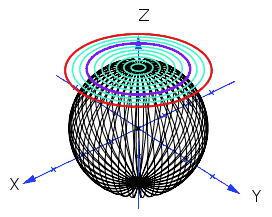3 random numbers to describe point on a sphere [duplicate]
I'm currently working on a problem involving computer graphics and got into a discussion about whatever or not constructing a 3d vector out of 3 random points uniformly distributed points between -1 and 1 (and then normalize the vector) to get points uniformly distributed over the surface of the sphere?
Note that I'm a computer science student not a math student and as such might not be able to follow the really complex stuff.
The other student said it would be better to instead pick 2 random points on a 2d plane and then warp those onto a sphere, however this to me seemed needlessly complex which one of us is right?
Methods to do this are discussed here: Wolfram MathWorld: Sphere Point Picking
In particular a programatically elegant approach is suggested by Marsaglia, stating that with $x_1,x_2\in(-1,1)$ chosen uniformly on this interval and throwing away cases where $x_1^2+x_2^2\geq 1$ we can define $$ \begin{align} x&=2x_1\sqrt{1-(x_1^2+x_2^2)}\\ y&=2x_2\sqrt{1-(x_1^2+x_2^2)}\\ z&=1-2(x_1^2+x_2^2) \end{align} $$ to obtain points $(x,y,z)$ uniformly distributed on the unit sphere. Quite clever!
The algorithm takes a point $(x_1,x_2)$ on the unit disc and transforms it to a point $(x,y,z)$ on the unit sphere. Here is a Dynamic Figure Illustrating this Transformation:

The purple circle in my diagram has radius $\sqrt{0.5}$ thus dividing the area of the unit disc in two halves - just like the tranformation of it divides the area of the unit sphere in two halves. This illustrates the main principle well, namely:
A uniform distribution on the unit disc is transformed into a uniform distribution on the unit sphere by Marsaglia's formulas.
Update
I just thought of this simple method which needs no advanced proof:
Pick $x,y,z\in[-1,1]$ which is what you already suggested. Now discard them if $x^2+y^2+z^2>1$ meaning that $(x,y,z)$ lie in the part of the unit cube that is outside of the unit sphere so in one of the corners. If not, normalize the vector $(x,y,z)$.
To avoid division by zero and precision errors you could also discard points with $x^2+y^2+z^2<\delta$ for some appropriate $0<\delta<1$ (as others have suggested in various comments).
Choosing the points uniformly from $[-1,1]^3$ and then normalizing does not give the uniform distribution on the sphere. The poles will get less mass than corners.
One way to get a uniform distribution would be to choose the $3$ coordinates with Gaussian distribution in $\mathbb{R}$ and then normalize.
Your vector will be uniformly distributed over a cube. The cube's vertex, however, is farhter from the inscribed sphere than the cube side's center, so a small region near the vertex will project to a smaller part on the sphere than the same volume region near the side's center. So the spherical distribution of the resulting points over the sphere will not be that uniform.
Anyway it may be close enough to your task, depending on what you need...
Or you may use any area-preserving 2-dimensional projection known in cartography - see https://en.wikipedia.org/wiki/Map_projection#Equal-area
If you're stuck to uniformly distributed PRNG, another option would be to use spherical coordinates, but transform uniformly distributed pairs of numbers to compensate for coordinate distortion.
Because of coordinate distortion, if you take just uniformly distributed pairs $(\vartheta,\phi)$ of numbers as spherical coordinates, you'll get too many points near poles. Recall that when integrating over a sphere, we use a Jacobian determinant of $\sin\theta$. So, we should have $P(\theta)\sim\sin\theta$. To get it, we have to take its inverse cumulative distribution function of our $\vartheta$.
Since $$\int_0^\vartheta \sin\vartheta~\text{d}\vartheta\sim\sin^2\frac{\vartheta}2,$$
and its inverse has the form of
$$\text{CDF}^{-1}(P)=\arcsin\sqrt P,$$
we can take for $\vartheta\in[0,\pi]$:
$$\theta=\arcsin\sqrt\frac\vartheta\pi.$$
Since Jacobian determinant doesn't depend on $\phi$, we don't have to transform this variable.
Now the pair $(\theta,\phi)$ is a pair of uniformly distributed on sphere spherical coordinates.
Since Marsaglia's formula for generating random points on a sphere is given in String's answer, I thought it would be useful to justify the formula.
In this answer, it is shown that the surface area of an annulus $a\le z\le b$ on the sphere is the same as the area of the strip $a\le z\le b$ on the cylinder tangent to the $x$-$y$ equator of the sphere. This means that the cylindrical projection of points uniformly distributed on the sphere, must also be uniformly distributed on the cylinder. That is,
The $z$-coordinate of the random points should be uniformly distributed.
Let $u_1$ and $u_2$ be uniformly distributed in $[-1,1]$. Consider $\left.u_1^2+u_2^2\,\,\middle|\,\,u_1^2+u_2^2\le1\right.$. Given that $u_1^2+u_2^2\le1$, $(u_1,u_2)$ is uniformly distributed in the unit disk, and therefore, $$ P[u_1^2+u_2^2\le r^2]=r^2\tag{1} $$ Equation $(1)$ shows that $u_1^2+u_2^2$ is uniformly distributed in $[0,1]$, and therefore,
$1-2(u_1^2+u_2^2)$ is uniformly distributed in $[-1,1]$
Therefore, we can let $z=1-2(u_1^2+u_2^2)$. Then, $$ \sqrt{1-z^2}=2\sqrt{u_1^2+u_2^2}\sqrt{1-(u_1^2+u_2^2)}\tag{2} $$
Since $(u_1,u_2)$ is uniformly distributed in the unit disk,
$\dfrac{(u_1,u_2)}{\sqrt{u_1^2+u_2^2}}$ is uniformly distributed on the unit circle.
Thus, $(2)$ and the highlighted statements shows that given $u_1^2+u_2^2\le1$, $$ \begin{align} x&=2u_1\sqrt{1-(u_1^2+u_2^2)}\\ y&=2u_2\sqrt{1-(u_1^2+u_2^2)}\\[4pt] z&=1-2(u_1^2+u_2^2) \end{align}\tag{3} $$ is uniformly distributed on the unit sphere.
George Marsaglia's formula $(3)$ requires an average of $8/\pi\doteq2.546479$ random numbers per point. If it is faster to evaluate a cosine and a square root than to generate $0.546479$ random numbers, then generate $u_1,u_2$ uniformly in $[-1,1]$.
Compute $\cos(\pi u_2)$, then $\sin(\pi u_2)=\mathrm{sgn}(u_2)\sqrt{1-\cos^2(\pi u_2)}$. $$ \begin{align} x&=\sqrt{1-u_1^2}\cos(\pi u_2)\\ y&=\sqrt{1-u_1^2}\sin(\pi u_2)\\[4pt] z&=u_1 \end{align}\tag{4} $$ is uniformly distributed on the unit sphere, without discarding any random numbers.